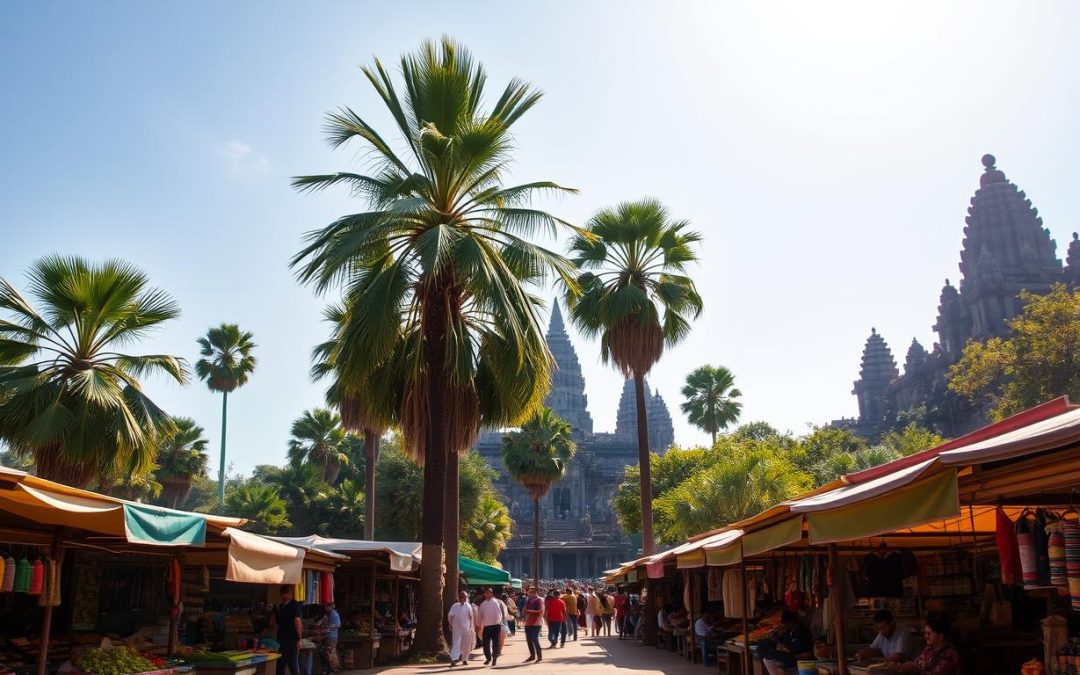Ever wondered when is the best time to explore a destination that blends ancient wonders with stunning landscapes? Timing your trip can make all the difference in your travel experience. In this guide, we’ll help you uncover the ideal months to visit this beautiful country.
Cambodia’s weather is shaped by distinct seasons, each offering unique opportunities for travelers. The dry season, from late November to early April, is known for clear skies and pleasant temperatures. However, it’s also the busiest time, especially in December and January.
Planning your trip around these patterns ensures you enjoy iconic sites like Angkor Wat under the best conditions. Whether you’re chasing sunny skies or prefer fewer crowds, this guide will help you make the most of your time in Cambodia.
Key Takeaways
- The dry season (November to April) offers ideal weather for travel.
- December and January are peak months with sunny skies and high tourist activity.
- Planning ahead helps you enjoy pleasant temperatures and avoid crowds.
- Cambodia’s weather patterns include wet and dry seasons, each with unique benefits.
- Understanding seasonal trends ensures a smoother and more enjoyable trip.
Understanding Cambodia’s Climate and Seasons
Understanding the climate of your destination can transform your travel experience. In this region, the weather is shaped by two distinct seasons: the wet and the dry. Each brings its own charm and challenges, making it essential to plan your trip accordingly.
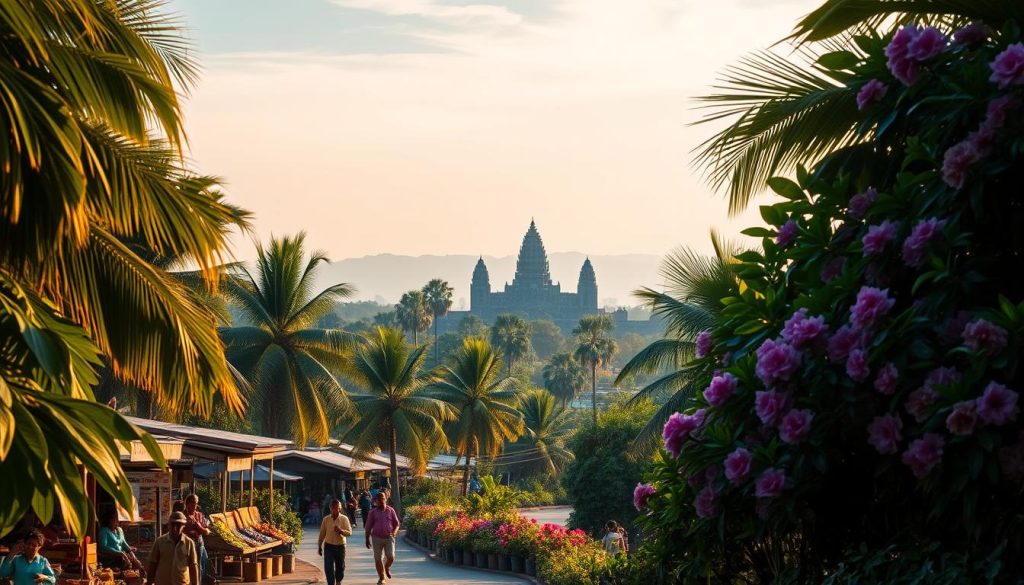
Overview of Wet and Dry Seasons
The dry season runs from November to April, offering clear skies and sunny days. This is the ideal time to explore iconic sites like Angkor Wat and Phnom Penh. Temperatures are pleasant, making outdoor activities enjoyable.
In contrast, the wet season spans from April to October. During this time, the Southwest monsoon brings frequent rain showers, especially in September. While the rain can be heavy, mornings often remain dry, perfect for early sightseeing.
Temperature, Humidity, and Rainfall Trends
Daily temperature trends play a big role in your comfort. During the dry season, average highs range from 77°F to 95°F. Humidity levels are lower, making it easier to explore without feeling sticky.
In the wet season, humidity peaks, and temperatures hover around 85°F. Rain showers are common, but they usually occur in the afternoon. This allows you to plan your day around the weather.
| Season | Months | Temperature | Rainfall |
|---|---|---|---|
| Dry | November – April | 77°F – 95°F | Low |
| Wet | April – October | 85°F | High |
Knowing these patterns ensures you’re prepared for any weather scenario. Whether you’re visiting Angkor Wat or strolling through Phnom Penh, understanding the climate enhances your holiday experience.
Cambodia: Best Months for a Weather-Savvy Trip
Choosing the right moment to visit can elevate your travel adventure. Balancing weather conditions with tourist density ensures a smoother and more enjoyable experience. Let’s dive into how you can identify your ideal travel window and make the most of your journey.
Identifying Your Ideal Travel Window
Shoulder months like November and March offer a sweet spot for travelers. During this time, the weather is pleasant, and crowds are thinner compared to peak months. This makes it easier to explore iconic sites like Angkor Wat without the hustle and bustle.
November often brings clear skies and comfortable temperatures, perfect for outdoor activities. March, on the other hand, marks the end of the dry season, with warm days and fewer tourists. These months are ideal for capturing stunning photos at historic temples and other landmarks.
Local Festivals and Weather Impacts
Local festivals can significantly influence your travel plans. For instance, the Khmer New Year in April is a vibrant celebration filled with cultural activities. However, this time also brings increased heat and larger crowds, which may affect your experience.
If you’re a traveler who enjoys cultural immersion, planning your trip around such events can be rewarding. Just be prepared for the weather and the influx of visitors. Balancing these factors ensures you enjoy both the festival atmosphere and the beauty of the country.
| Month | Weather | Crowd Level |
|---|---|---|
| November | Clear skies, mild temperatures | Moderate |
| March | Warm, end of dry season | Low to Moderate |
| April | Hot, festival season | High |
By considering both weather and cultural events, you can plan a trip that aligns with your preferences. Whether you’re exploring ancient temples or soaking in local traditions, timing your visit wisely enhances your overall travel experience.
Planning Your Trip Around Peak and Shoulder Seasons
Planning around peak and shoulder seasons ensures a smoother trip. Whether you’re exploring Angkor Wat or strolling through Phnom Penh, timing your visit can make a big difference. Let’s dive into how you can manage crowds, save money, and enjoy your journey to the fullest.
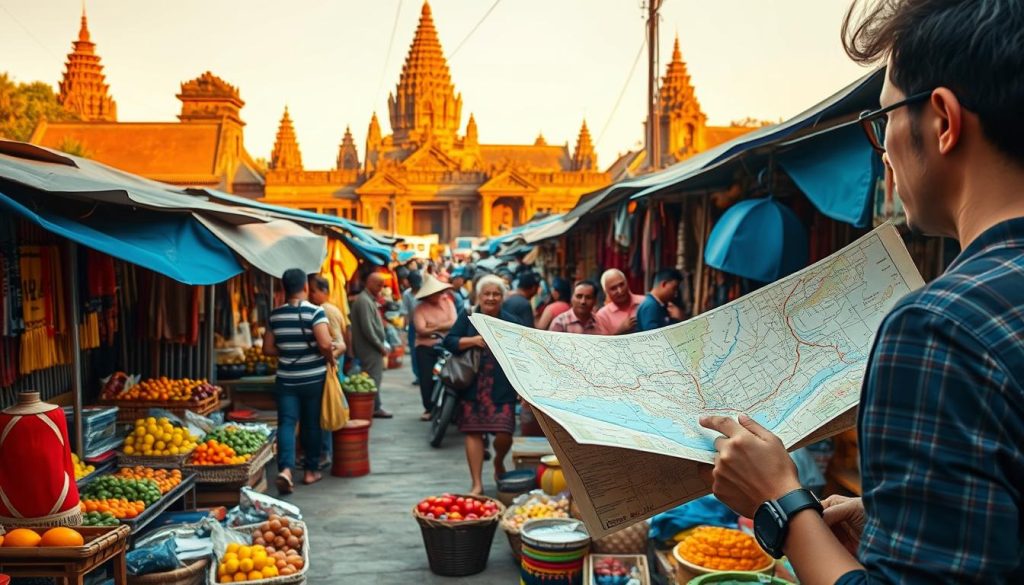
Managing Tourist Crowds at Iconic Sites
Peak season, from December to February, attracts heavy tourist flows. Iconic sites like Angkor Wat can get crowded, especially during holidays like the Lunar New Year. To avoid long lines, consider visiting early in the morning or late in the afternoon.
Shoulder months like November and March offer a more relaxed experience. During this time, you’ll find fewer tourists and more opportunities to explore at your own pace. Hiring a local driver can also enhance your temple-hopping adventure, especially during off-peak hours.
Optimizing Travel Costs and Accommodation
Traveling during shoulder seasons can save you money. Flights and accommodation prices are often lower compared to peak months. For example, April and May are quieter, making it easier to find affordable stays in Siem Reap.
Here’s a quick comparison of peak and shoulder seasons:
| Season | Months | Crowd Level | Price Range |
|---|---|---|---|
| Peak | December – February | High | Expensive |
| Shoulder | November, March | Moderate | Affordable |
By planning your trip during shoulder seasons, you can enjoy vibrant attractions without the stress of large crowds or high prices. Whether you’re exploring ancient temples or soaking in local culture, timing your visit wisely enhances your overall experience.
Regional Highlights and Seasonal Attractions
Exploring Cambodia’s regional highlights offers a mix of history, culture, and natural beauty. From the ancient ruins of Angkor Wat to the vibrant streets of Phnom Penh, each area has its own unique charm. Timing your visit to align with the right season can enhance your experience and make your trip unforgettable.
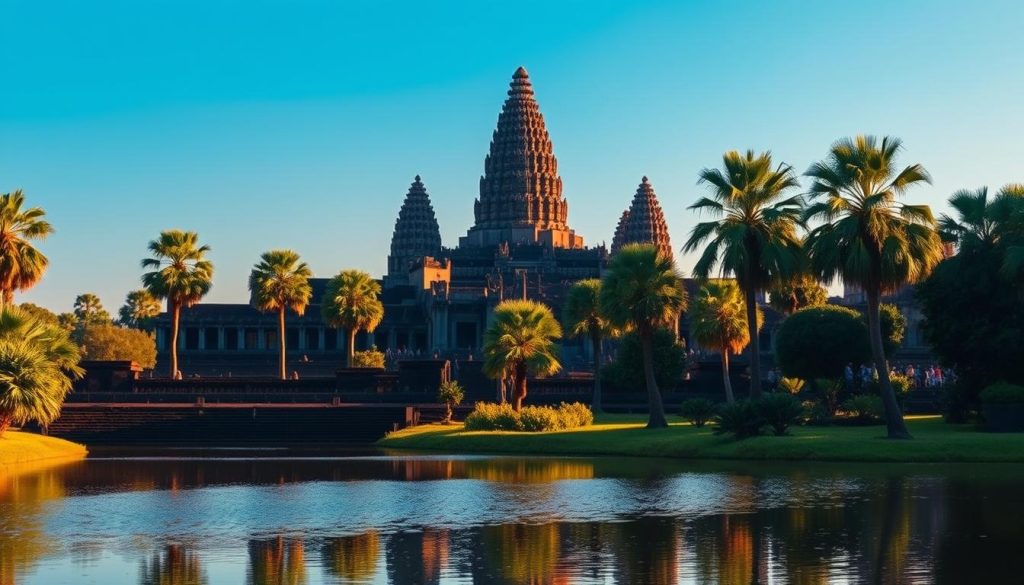
Exploring Angkor Wat and the Temples of Siem Reap
The temples of Siem Reap, especially Angkor Wat, are must-see attractions. These ancient structures, dating back to the 9th century, are surrounded by lush greenery and intricate carvings. Visiting during the dry season (November to April) ensures clear skies and comfortable temperatures, perfect for exploring.
If you prefer fewer crowds, consider traveling in November or March. These shoulder months offer a more relaxed experience. Early mornings are ideal for temple visits, as the weather is cooler and the light is perfect for photography.
Discovering Phnom Penh’s Cultural Gems
Phnom Penh, the capital city, is a hub of cultural and historical attractions. From the Royal Palace to the National Museum, there’s plenty to explore. The city’s vibrant area also offers diverse sightseeing options, including bustling markets and riverside promenades.
During the wet season (May to October), the city’s greenery is at its peak, creating a stunning backdrop for your photos. While afternoon rain showers are common, mornings are usually dry, making them the best time for outdoor activities.
| Region | Best Time to Visit | Key Attractions |
|---|---|---|
| Siem Reap | November – March | Angkor Wat, Bayon Temple |
| Phnom Penh | November – February | Royal Palace, National Museum |
Understanding regional seasonal variations helps you pick the best time to visit. Whether you’re exploring ancient temples or soaking in local culture, timing your trip wisely enhances your overall travel experience.
Tips for a Weather-Savvy Visit to Cambodia
Packing smart can make or break your travel experience in this Southeast Asian gem. With its distinct seasons, preparing for varying conditions ensures you stay comfortable and ready for adventure. Whether you’re exploring ancient temples or bustling cities, these tips will help you navigate the weather like a pro.
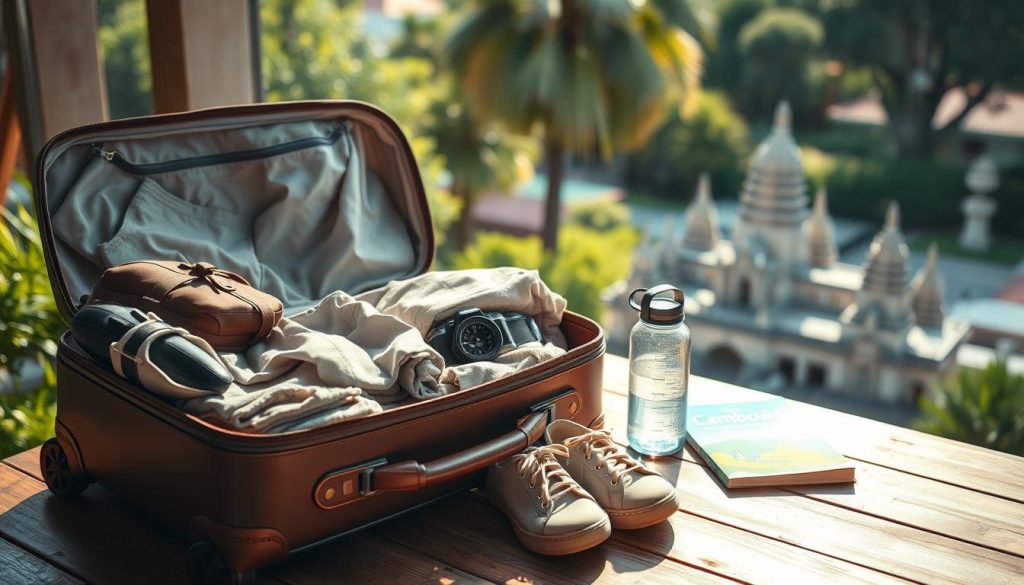
Essential Packing and Clothing Advice
Lightweight, breathable clothing is a must for the warm temperatures. Opt for moisture-wicking fabrics to combat the humidity. A lightweight rain jacket is essential, especially if you’re visiting during the wet season from May to October.
Don’t forget sunscreen with high SPF and insect repellent to protect your skin. Comfortable footwear is crucial for long walks at temple sites like Siem Reap. A pair of sturdy sandals or walking shoes will keep your feet happy.
Staying Comfortable in Heat, Rain, and Humidity
To beat the heat, stay hydrated and take breaks in shaded areas. Choose accommodation with air conditioning or fans for a comfortable retreat. During the rainy season, plan outdoor activities for the morning when showers are less frequent.
Carry a small umbrella or poncho for sudden downpours. A reusable water bottle and a hat can also help you stay cool and protected from the sun.
| Item | Purpose |
|---|---|
| Lightweight Clothing | Comfort in high temperatures |
| Rain Jacket | Protection during wet season |
| Sunscreen | Shield from UV rays |
| Comfortable Footwear | Ease of movement at temple sites |
By packing wisely and planning ahead, you can enjoy your time in this beautiful place without worrying about the weather. Check the forecast before your trip to ensure you’re fully prepared for the conditions.
Additional Planning Considerations
Navigating travel logistics can significantly enhance your trip. From booking transportation to organizing your itinerary, a little preparation goes a long way. Let’s explore how you can streamline your journey and make the most of your time in this vibrant destination.
Travel Logistics and Local Transportation
Getting around is easier when you know your options. In cities like Phnom Penh and Siem Reap, tuk-tuks and taxis are reliable choices. For longer distances, buses are affordable and convenient. Researching these options in advance saves you time and stress.
If you’re visiting during the wet season, plan for potential delays. Ferries and buses may take longer due to weather conditions. Always carry cash, as ATMs are limited in remote areas.
Booking Passes and Managing Itineraries
Multi-day passes are a smart investment for popular attractions like Angkor Wat. These passes allow you to explore at your own pace and avoid daily ticket lines. Booking online in advance ensures you secure your spot, especially during peak season.
When planning your itinerary, consider local festival dates. Events like the Khmer New Year can affect crowd levels and prices. Arriving early or late in the day helps you avoid the busiest times at top sites.
By staying informed and organized, you can enjoy a smoother and more enjoyable travel experience. Whether you’re exploring ancient temples or bustling cities, these tips ensure you make the most of your journey.
Conclusion
Timing your visit to this destination can greatly enhance your experience. The dry months, particularly from November to February, offer the most favorable weather for exploring iconic sites like Angkor Wat and the cultural gems of Phnom Penh. These months provide clear skies and manageable crowds, making your journey more enjoyable.
While the wet season brings occasional rain, it also offers lush landscapes and fewer tourists. Planning your trip around these patterns ensures you make the most of your time. Whether you’re exploring ancient temples or vibrant cities, understanding the climate helps you prepare for any weather scenario.
Use the tips shared in this guide to tailor your itinerary to your preferences. Being weather-savvy ensures a smoother and more rewarding adventure. So, pack wisely, plan ahead, and get ready to explore this historic area with confidence.
The above is subject to change.
Check back often to TRAVEL.COM for the latest travel tips and deals.
Here are some Tours & Sightseeing suggestions that might pique your interests!
